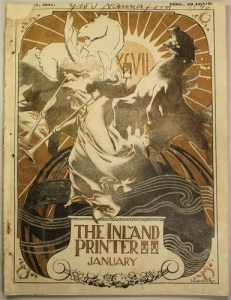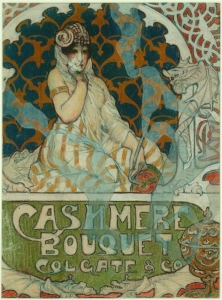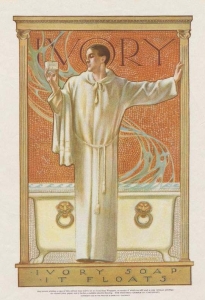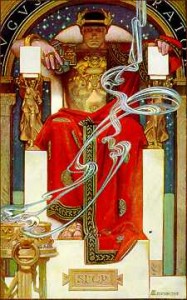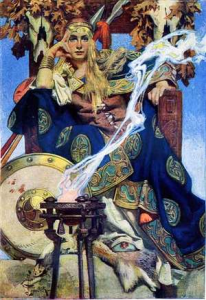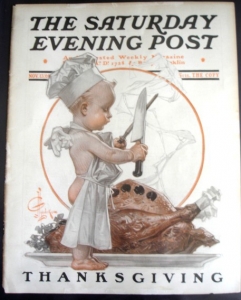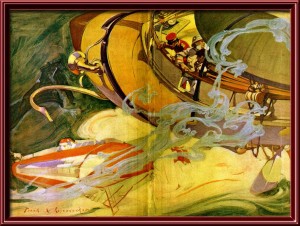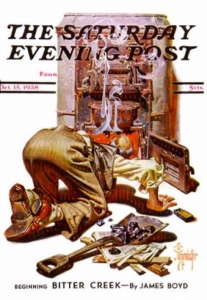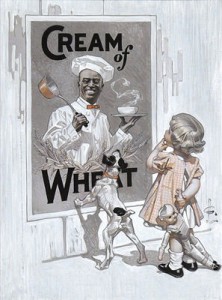Shifting Visions of Vaporous Artistry
By Joyce K. Schiller, Curator, Rockwell Center for American Visual Studies
There is something distinctive and magical about the way J. C. Leyendecker conveyed the fleeting properties of steam, smoke, and fog in his illustrations. His stylized (sometimes art nouveau-inspired) renditions of air-borne particulate matter first appeared while he was in Paris (1896-98) with his brother Frank X. studying at the Académie Julian following their training at the School of the Art Institute of Chicago. J. C.’s January 1897 cover illustration for The Inland Printer is perhaps the earliest example revealing his fascination with picturing a visually ephemeral but decorative aspect of our environment. Here wind-moved clouds are expressed as thinly applied repetitive horizontal lines that seem to wiggle and flow over the surface of the armillary sphere that represents both the earth and the months of the year as indicated by the astrological symbols on the band adorning the width of the sphere. The breeze is just one part of the image that expresses movement—the fluttering of the angle’s clothing and the leaping of Apollo’s horses who drag the sun in their wake all move to support the heralding of the new day and the new year.
Soon Leyendecker would abandon his initial sketchy approach and instead focus on expressing the billowing shifting, wafting quality of smoke, steam, or scent as may be seen in an undated advertising illustration he created for Cashmere Bouquet soap or another for Ivory Soap. By 1900 it is clear that for J. C. Leyendecker, imaging steam, smoke, fog, and even water has developed into a recognizable stylizations—one part art
nouveau influence and one part awareness of how these transitory characteristics visually appear. The steam rising from the bath tub in the Ivory Soap ad becomes Leyendecker’s stylized solution. There are a variety of other examples in the illustrator’s oeuvre, so we will look at only a few of these.
In 1905 and 1907 Leyendecker portrayed smoke rising from a brazier conveying the linear quality of its floating whirling, twirling nature in two color-printed illustrations, seen above. In 1909 J. C. used the technique to render steam rising from the perfectly cooked Thanksgiving turkey just before the bird is carved by baby angel (putti) decked out in a chef’s toque blanche and over-sized white apron. Because the delectable steam is painted white against white, it is a little difficult to see (below left).
That same year, his brother Frank created the cover illustration and story illustrations for a Rudyard Kipling book about the future, With the Night Mail: A Story of 2000 A.D. (New York: Doubleday, Page and Co., 1909). F. X. Leyendecker’s story illustrations (see one above right) incorporate J. C.’s stylized smoke/cloud formulation as it wafts through the air and past the dirigible Kipling prophesied would carry mail between the United States and Canada. This borrowing is an unusual but not unique occurrence. Besides conveying the ephemeral nature of the vapor in these images, the inclusion of the floating painted rendition of these elements provides movement in what could seem to be essentially static scenes. This is especially true when J. C. incorporates this component into his illustrations.
J. C. Leyendecker would return to his distinctive, almost formulaic, rendition of smoke, steam, fog, and sometimes even air-borne dirt throughout his career. If you think about it, this repetitive approach to these transitory visual effects might even be described as one of those iconic, recognizable aspects of his illustrations— like his illustrations of beautiful young men modeling elegant clothing to his many holiday baby illustrations—J. C. Leyendecker’s shifting visions of steam, smoke, and fog rising, lifting and twisting through his compositions are uniquely recognizable even as they waft away.
* Identification of all illustrations included in this posting will be listed below in order of presentation:
J. C. Leyendecker (1874-1951);
J. C. Leyendecker (1874-1951); Cashmere Bouquet, n. d.; advertising illustration for Colgate & Co.
J. C. Leyendecker (1874-1951); Ivory Soap ∙ It Floats, 1900; Advertisement for Ivory Soap bars for Proctor and Gamble Company [under the image, Proctor and Gamble offered any one who was interested a 14 x 17 inch copy of this ad “a suitable size for framing.”
J. C. Leyendecker (1874-1951); color illustration for “A Christmas Hymn” by Alfred Domett in The Century Magazine (December 1905)
J. C. Leyendecker (1874-1951); Queen Meave [sic.] for “The Ancient Irish Sagas” by Theodore Roosevelt in The Century Magazine (January 1907)
J. C. Leyendecker (1874-1951); Thanksgiving Cupid sharpening knife to carve steaming turkey, 1909; Cover illustration for The Saturday Evening Post, (November 13, 1909)
Frank X. Leyendecker (1879-1924); story illustration for With the Night Mail: A Story of 2000 A.D. by Rudyard Kipling (New York: Doubleday, Page and Co., 1909)
J. C. Leyendecker (1879-1924); Starting the Furnace, 1938; Cover illustration for The Saturday Evening Post (October 15, 1938)
J. C. Leyendecker (1874-1951); A Dainty Breakfast, 1909; advertising illustration for Cream of Wheat; Oil on canvas
August 7, 2014
By Joyce K. Schiller, Curator, Rockwell Center for American Visual Studies, Norman Rockwell Museum


